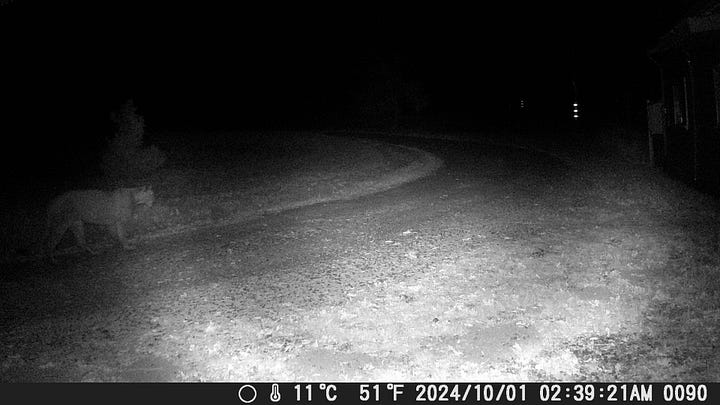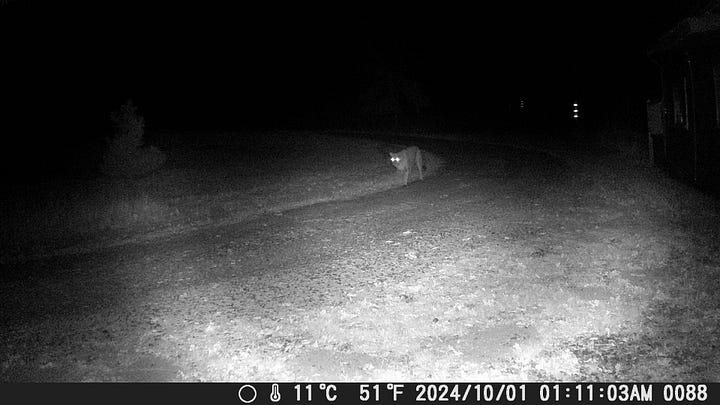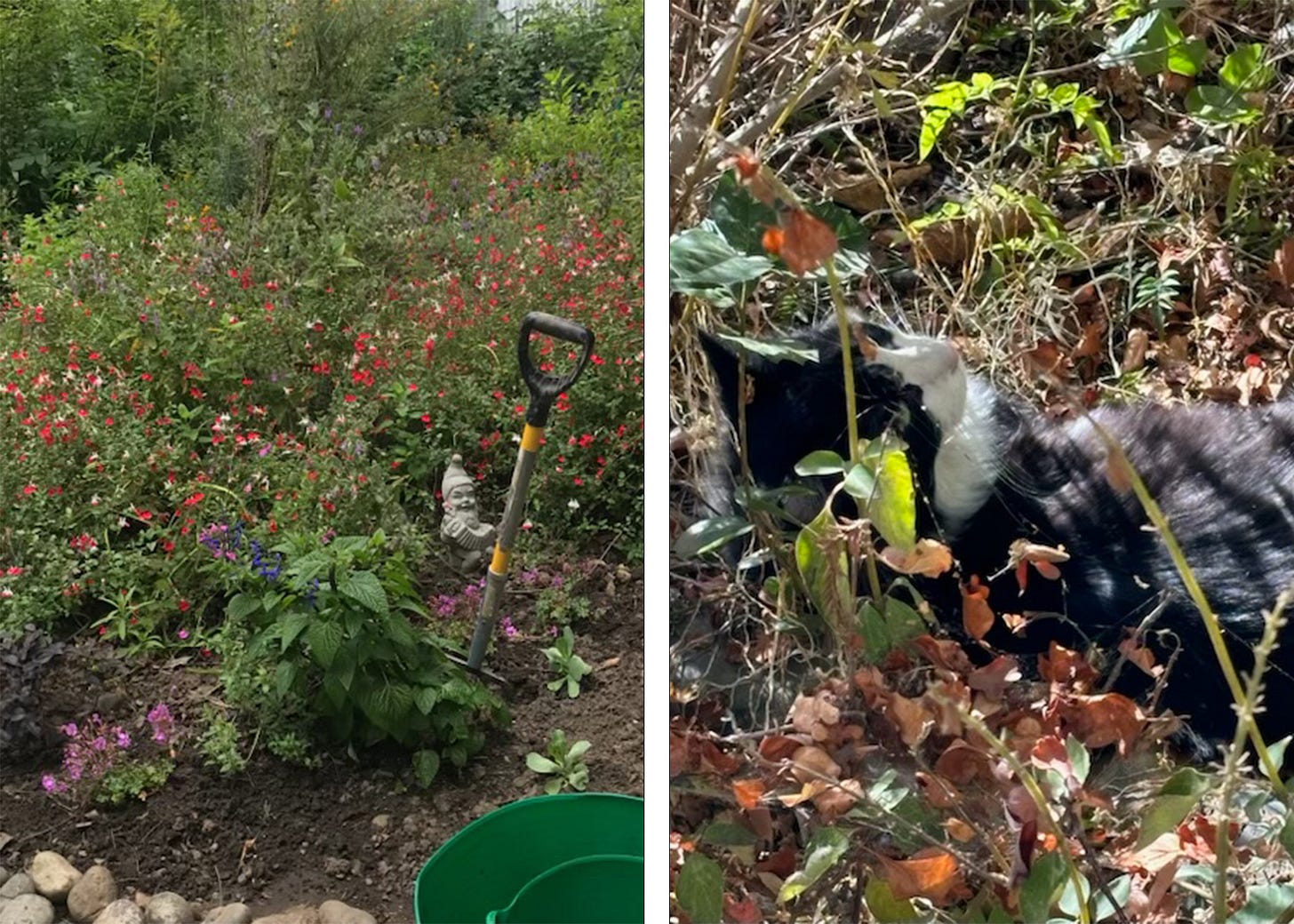Green Wednesday: Gardening for Wellness and Living Among Mountain Lions
By Cindy Watter, UC Master Gardener of Napa County / By Kathleen Scavone, Environmental Contributor
Before we dive into this week’s “Green Wednesday” stories, we want to remind you that Napa Valley Features is a subscriber-funded publication. Without support from new and recurring paid subscribers, stories like these could diminish or the entire publication could be forced to close. If you value our ad-free conflict-free veteran-owned local reporting, please consider becoming a paid subscriber. For as little as 16 cents a day, you can help keep local news independent, relevant and sustainable.
Every Wednesday, Napa Valley Features includes posts from environmental voices and the UC Master Gardeners of Napa County, who share research-based horticultural advice. Together, these contributors provide valuable insights into sustainable gardening practices and climate-related topics relevant to our region.
"Gardening for Wellness" by Cindy Watter, UC Master Gardeners of Napa County: This article explores the mental and physical benefits of gardening, including its therapeutic effects on mental health, exercise and social interactions.
"Encountering Enigmatic Mountain Lions" by Kathleen Scavone, Environmental Contributor: Highlighting sightings and behaviors of mountain lions in Napa County, this piece provides insights into the life and habits of these elusive creatures and offers safety tips for living in mountain lion habitats.
Gardening for Wellness
By Cindy Watter
NAPA VALLEY, Calif. – Many years ago, in the age BCE (Before Canidae Era), I had a nice-looking yard, with herbaceous borders, roses, the usual. It rained more back then, so upkeep wasn’t such a challenge. Then I got a dog, and her favorite hobby was laying on/digging in anything green and cushiony.
I let my yard transition into a wildlife refuge—possums, raccoons, squirrels, hummingbirds and the odd feral cat. We had some rats, too, but I always blamed those on the neighbors.
Even after joining Master Gardeners, my yard showed only a small improvement. I revived my compost pile and pulled out a passionflower vine with the same girth as that of a boa constrictor that was threatening my walnut tree. But when COVID-19 hit, I had to do something besides read plague literature (especially because “The Magic Mountain” was so depressing it took me eight months to finish it). My normally robust mental health was decaying, so I set about working in the backyard.
And I wasn’t the only one. Millions of people around the world took up backyard gardening. My husband and I hadn’t spent so much concentrated time together in years, I realized. Most days it was just us and the dog (a puppy, whose destructiveness was minor because she was so small). We pulled weeds, turned compost, moved a pile of river rocks to edge perennial beds and propagated plants. I did run to Van Winden’s a few times, where the customers were appropriately distanced and most of the transactions took place outside. And I felt better!
Gardening is healthful for body and mind. First, gardening is exercise. It can be strenuous or gentle, but any exercise is better than none. A repetitive task—such as compost turning—can burn a lot of calories over time. Of course, moving rocks burns more.
The physical activity ranges from moving heavy loads to gently stretching—something for everyone. Regular exercise can prevent dementia. Second, being outdoors is relaxing. Even the most tedious chore (see river rocks above) is made more pleasant when you start observing what is going on around you in the natural world.
In the spring, birds and squirrels engage in their courtship rituals, which are amusing. I found that as the spring wore into summer, birds became used to my presence, and they would eat blueberries that were four inches from my head. My puppy stopped chasing them and would sit still for an hour, watching a robin splash in a pan of water.
As the year progressed, I watched birds build nests in the berry vines that I refuse to cut down, and later the squirrels hid walnuts everywhere. I became better at identifying a particular bird’s song, too.
According to Forbes magazine, we produce more serotonin, a natural hormone, when we are in a pleasant environment, such as a garden or other green space. Serotonin is known as the “feel good” hormone and contributes to a sense of well-being.
Garden therapy is not a new idea. In the 19th century, wealthy people who had nervous breakdowns went on rest cures that always featured gardens. Florence Nightingale was a strong supporter of therapeutic gardens. Gardening is a mental health treatment in Europe today.
Gardening can also be a social activity. Interaction with other people (and gardeners are positive people) strengthens mental health and resilience. In Napa, we have a community garden, and its produce goes to the local food bank. The volunteers there look forward to their shifts and seeing their friends.
The Napa County Master Gardeners who developed the gardens at Napa’s Las Flores Community Center also enjoy working together. I just visited the Donaldson Way Elementary School Garden in American Canyon, and it is a joyful place, with many educational activities for the students. No matter what happens to those children in the future, I think they will remember their school garden fondly.
As for my own post-Covid garden, it needs help, thanks to other obligations and natural indolence, but mostly to going on vacation in July (never again). Just in case my mental health is challenged in the next few months, I am getting it back in shape.
You can see before and after pictures here (I really have no shame). The first shows a flower bed in progress, with water-wise plants. Observe the mulch and other evidence of good gardening practices. The second picture is what happens when you don’t prune your plants. In my case, a neighbor’s cat has moved in. His name is Matteo. We can’t extract him without major trimming, and he is not impressed at all by my dog’s excited barks. At least he hasn’t eaten any birds.
I am looking forward to tidying up the flower beds. Their overgrowth is evidence that they not only survived but flourished, and I will, too.
Help Desk: The Master Gardener Help Desk is available to answer your garden questions on Mondays and Fridays from 10 a.m. until 1 p.m. at the University of California Cooperative Extension Office, 1710 Soscol Avenue, Suite 4, Napa. Or send your questions to mastergardeners@countyofnapa.org. Include your name, address, phone number and a brief description.
If today's story captured your interest, explore these related articles:
Cindy Watter is a UC Master Gardener of Napa County.
Encountering Enigmatic Mountain Lions
By Kathleen Scavone
NAPA VALLEY, Calif. — It should have come as no surprise to discover the photograph of an elusive and secretive mountain lion on my south Middletown game cam. Neighbors have reported sightings for years, and I've noted several deer caches on my 6 acres over time. A deer cache is an ecological interaction between animals in nature, when a carnivore such as a bobcat or mountain lion kills a deer and then partially buries it in leaves or dirt.
Since bobcats are more likely to take down rodents or rabbits, the caches I've found are most likely those of a mountain lion. I would have been able to make a proper determination had I known at the time to look for specific signs on the animal carcass, such as whether the large bones such as the femurs, vertebrae or skull had been chewed. Viewing the critter-cam photo, I felt equally thrilled and anxious, since the large and languorous cat was strolling near my pottery studio.


Puma, panther, cougar or mountain lion, whichever moniker you choose, there are numerous mountain lions that roam Napa County, according to Marain Smith, California Department of Wildlife's conflict specialist.
"We get regular reports of mountain lion sightings across the region,” Smith said, “generally from ring cameras and security footage as mountain lions are very good at avoiding being seen, but also the occasional in-person sighting."
In order to remain safe in mountain lion country, Smith recommends reviewing the CDFW's Human-Mountain Lion Conflict website, which also includes lots of information about the history of mountain lions in California and the current conservation efforts and policies. Smith also recommends viewing the Sonoma County Wildlife Rescue website as it has a good page for how to build a good predator-proof enclosure.
"Mountain lions are rarely a threat to humans,” Smith said. “However, they are interested in livestock and pets. Please keep pets inside for their safety and never leave them outside unsupervised, especially at night. The most common mountain lion attacks we see are on small hoof stock like goats and sheep. If folks have livestock, we strongly encourage them to keep them locked up at night in a secure, fully enclosed night pen.”
She said other deterrents include motion-activated noise deterrents, electric fencing and livestock guardian dogs. If you ever have a mountain lion sighting or would like to discuss how best to protect your livestock, you can reach out to her department by calling their office in Fairfield at (707) 428-2002 or making a report with the Wildlife Incident Reporting system. She said these reports help them better understand mountain lion behavior across the state.
An estimated mountain lion count in California or Napa County is not available at this time, according to Jason Lombardi, CDFW's statewide large carnivore research coordinator. He said that there is plenty of open-space habitat for mountain lions in Napa County.
"There is available habitat for mountain lions to live in Napa County; mountain lions occupy most forested areas of the state,” he said. “However, due to extensive roadway networks, there may be limited permeability across major roadways in different parts of the county, especially closer to the San Francisco Bay."
Have you ever heard the sound of a puma? According to information provided by the Bay Area Puma Project: "Pumas do not have the part of the larynx that allows them to roar, so they chirp, whistle, growl, hiss and scream."
They describe pumas' physical characteristics with the female weighing in at 70 to 145 pounds and the male's weight at 80 to 200 or more pounds. The majestic animals' length averages from 5 to 9 feet, nose to tail-tip. The long lion tail is around 40% of their body-length, and it provides a service to the animal to aid in balance. The powerful puma's back legs allow them to jump up to 22 feet vertically and around 30 feet horizontally.
Mountain lions' average lifespan in the wild is six to 13 years. Pumas persist in both North and South America, and around one-half of California is considered habitat to these mighty creatures. They typically inhabit densely interwoven canyons and forests where they know to ambush their prey near rocky protrusions, from trees or from all but impenetrable underbrush. Their diet consists of deer, coyotes, raccoons, wild pigs, rodents such as gophers and mice, and insects.
If you happen upon a large, round track in the mud with three scallops evident on the back portion of the heel pad, you might be on the path of a puma. This is lucky because the marks of this powerful predator are rarely seen. But if the thought of living amongst mountain lions is disconcerting to you, take heart in knowing that your wild neighbors prefer to stay clear of humans. Mountain lion attacks are so rare that since 1890 there have only been 16 proven mountain lion attacks, with a half-dozen fatalities. It's a source of wonder that in our ever-changing 21st century world wild things such as mysterious mountain lions persist.
If today's story captured your interest, explore these related articles:
Napa's Path to Sustainability: Weaving Local Plans Into One Resilient Future
Birdwatching in Napa County Reveals Avian Wonders and Conservation Champions
Calistoga's Old Faithful Geyser: From Tourist Trap to Natural Wonder
Kathleen Scavone, M.A., retired educator, is a potter, freelance writer and author of three books: “Anderson Marsh State Historic Park: A Walking History, Prehistory, Flora, and Fauna Tour of a California State Park,” “People of the Water” and “Native Americans of Lake County.” She loves hiking, travel, photography and putzing in the garden.








Your comment about Covid reading and The Magic Mountain is hilarious! You could call your column "Gardening with humor for wellness."